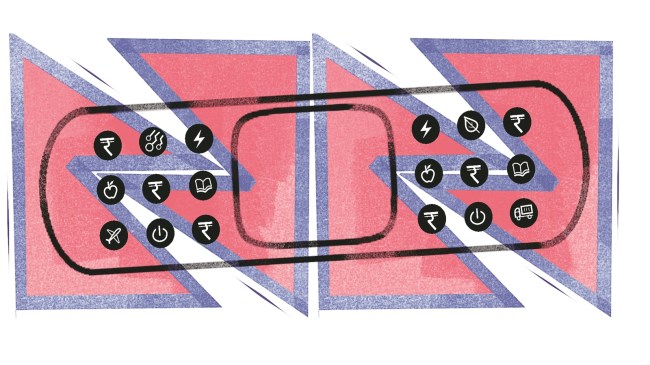Opinion Best of Both Sides: Amid crisis, India must reset its Nepal policy
It remains unclear who will lead the transition in Nepal. Delhi will need to engage with the new order with tact and sensitivity.
 Rocked by protests and ouster of the K P Oli government, Nepal
is in the grip of uncertainty. Where does Kathmandu go from here, and Delhi? (Illustration by C R Sasikumar)
Rocked by protests and ouster of the K P Oli government, Nepal
is in the grip of uncertainty. Where does Kathmandu go from here, and Delhi? (Illustration by C R Sasikumar) Nepal’s political revolution this week reminds us that, more than any foreign hands, the recent crises in South Asia are symptoms of a massive economic, demographic, and political churning across the region. India will have to deal with this turmoil, not only by defensively minimising risks but also by actively supporting the transformation of its neighbouring countries. It has done so in Sri Lanka, after its worst financial crisis in 2021. It promises to re-engage with a new leadership in Bangladesh after the elections in 2026. Until then, India must focus all its attention on supporting a crucial transition towards a new, more democratic and developed Nepal.
The spontaneity and violence of this week’s protests must be understood in the context of a wave of discontent that had been brewing against a small, geriatric, and nepotistic leadership that ran Nepal with 17 different prime ministerships in the last 20 years. Coupled with economic stagnation, rising inequality, and one of the world’s youngest populations (median age 25), it was only a question of time until things flared up. What role should India now play beyond just being a passive bystander?
Prime Minister K P Sharma Oli’s resignation marks the end of a generation of leaders who have worked both with and against India through every possible constellation and coalition since 2006. Oli’s last incarnation turned out to be particularly difficult for New Delhi. To distract from domestic discontent and economic slowdown, he mobilised the Nepali electorate against India during the 2020 border crisis, even as he proved incapable or unwilling to lead urgent reforms and deliver on the India-Nepal economic connectivity agenda.
This week thus marks a turning point also for India-Nepal relations, and it is unlikely that anyone in New Delhi is shedding crocodile tears for the ousted leadership. With much of traditional Kathmandu’s political edifice literally burnt to ashes, the prospect of a new Nepal now arises.
While it remains unclear who will lead the transition and in what direction, the current context offers an overall opportunity for India to reset its Nepal policy. As it did in the past, whether in 1951, 1990, or 2006, New Delhi can facilitate another step towards the dream of a stable
Nepal through a more federal democracy and inclusive development.
To achieve this, India will have to deploy the power of its diplomacy coupled with much political tact to both understand and cater to the aspirations of a new generation of Nepali leaders. Five challenges stand out.
First, India must deepen its engagement with a new generation of Nepali leaders, both within but also beyond the traditional big parties. This group of emerging activists and leaders, in the 20-50 age group, are either oblivious about India or grew up influenced by Oli’s anti-India campaigns. The challenge will also be to move beyond Kathmandu, into Nepal’s federal provinces, and engage with new voices there, particularly across the Madhesi region.
Second, India will have to resist the temptation to equate state stability with political personalities. Former King Gyanendra is the most obvious conservative example of the belief that any one towering figure will be able to concentrate power to ensure governance stability. Instead, political stability will come from a vibrant, multi-party and representative democracy: This is in India’s interest because it has, time and again across South Asia, proven to be the best system for diverse and pluralist societies such as Nepal.
Third, India will have to show much tact and sensibility to engage with Nepal without being seen to interfere in Nepal. This is a tough task: Since 1947, India has always been perceived by its smaller neighbours as a regional hegemon, an elephant that is capable of both productive and destructive effects, whether through the power of intervention or inaction. In a time where foreign policy has become deeply political and neighbouring country leaders activate “India Out” to get votes, Delhi will have to tread carefully but also persist in pursuing its interests with a thick skin.
Four, and most important: India will have to double down on economic interdependence with Nepal. As seen in Sri Lanka or Bangladesh, political transitions are usually harbingers of economic slowdown: Whoever takes power in Kathmandu in the next few weeks will be in dire need of financial assistance to keep the economy running and to buy themselves time on the political street. With limited appetite from China and traditional Western donors to come to Nepal’s rescue, this will put a burden on India.
Yet, New Delhi should see this as an opportunity to accelerate its successful connectivity strategy with Kathmandu. For the last few years, India has been able to deliver more, faster, and better support to Nepal’s development aspirations. By upgrading border transportation infrastructure and giving access to its seaports, India has driven Nepali exports to break new records. A dream of many decades, Nepal’s hydropower potential has seen new investments and support from India, facilitating energy exports to Bangladesh.
Beyond the political, it is this delivery-oriented economic dimension in India’s Nepal policy that will eventually bring the biggest dividends for both sides. Nepal’s ambitions to become a middle-income country rely on more, not less, Indian trade and investments. To make the relationship truly “special,” as leaders on both sides like to profess, India will have to prove its mettle as a reliable partner to provide Nepal with multiple solutions across the technology and digital domains; the transportation, energy, and climate sectors; and the health and education systems.
The writer is senior fellow in Foreign Policy and Security Studies at the Centre for Social and Economic Progress (CSEP), New Delhi






